Choosing the right cookware can make or break your cooking experience. Whether you’re a seasoned chef or someone who just loves to whip up quick weekday meals, your pots and pans are your most important tools. The debate between nonstick vs. stainless steel cookware has been raging for decades, and for good reason — both have unique benefits and drawbacks that affect everything from flavor and texture to health and maintenance.
Nonstick cookware promises convenience — smooth surfaces that let food glide right off, minimal oil usage, and easy cleaning. Meanwhile, stainless steel is prized for its durability, heat control, and ability to sear food beautifully. So, which one truly deserves a spot in your kitchen? The answer depends on your cooking style, priorities, and the types of dishes you love to make.
This guide dives deep into the differences between nonstick and stainless steel cookware, exploring their materials, performance, safety, and more. By the end, you’ll know exactly which option suits your everyday cooking needs best — or if you actually need both.
Top Picks
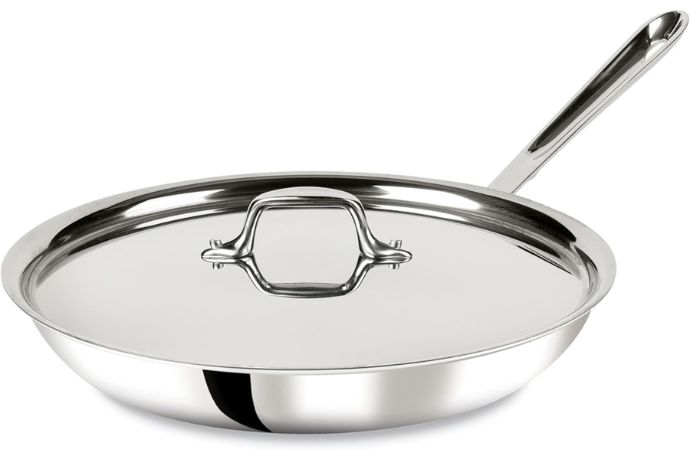
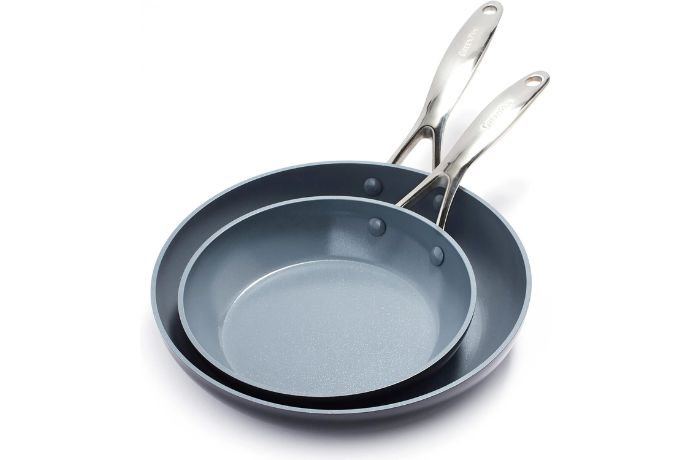
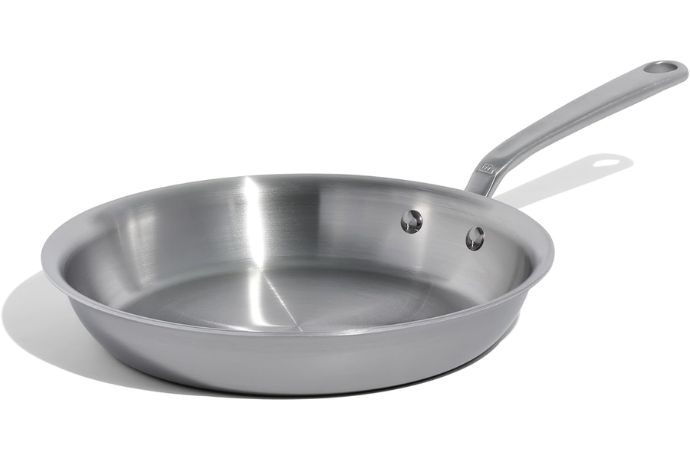
As an Amazon Associate, we may earn from qualifying purchases. This does not affect the price you pay.
The Battle of Cookware in Every Kitchen
Every kitchen tells a story — and in most, there’s a quiet rivalry happening right on the stove. Nonstick pans sit gleaming with ease and convenience, while stainless steel pots represent the strength and precision of traditional cooking. But how do you decide which one truly fits your lifestyle?
Why Choosing the Right Cookware Matters
Think of cookware as an extension of your cooking personality. The right pan can help you cook faster, more evenly, and with better results. For example, if you enjoy making omelets or pancakes every morning, nonstick cookware offers effortless release and quick cleanup. On the other hand, if you love to sear steaks, caramelize onions, or deglaze pans for sauces, stainless steel gives you the heat power and control to do it like a pro.
Choosing the right cookware also impacts your health, wallet, and even the environment. The materials, coatings, and lifespan of your pots and pans determine not only how long they’ll last but also how safe they are for daily use. That’s why understanding the core differences between nonstick vs. stainless steel cookware is more than just a matter of taste — it’s a practical decision that affects your overall cooking journey.
Understanding Your Cooking Habits Before Deciding
Before you choose between nonstick and stainless steel, take a moment to think about what and how you cook. Do you mostly prepare delicate foods like eggs, fish, or crepes? Then nonstick is your best friend. Are you more into sautéing vegetables, browning meat, or making sauces? Stainless steel wins hands down.
Your cleaning habits matter, too. If you prefer easy, low-maintenance kitchen tools, you’ll appreciate nonstick’s simplicity. But if you enjoy the ritual of cooking and don’t mind a little scrubbing, stainless steel’s resilience and long-term value are unbeatable.
In short, your cooking style is the real deciding factor — not just what the labels say.
What Is Nonstick Cookware?
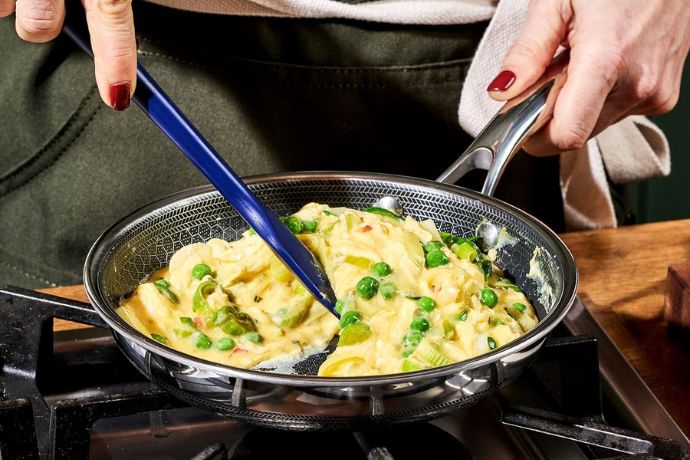
Composition and How It Works
Nonstick cookware is designed to make cooking and cleanup nearly effortless. The base is typically made from aluminum or hard-anodized aluminum for excellent heat conductivity, while the surface is coated with a nonstick material — traditionally PTFE (polytetrafluoroethylene), known by its brand name Teflon. This coating prevents food from sticking, allowing you to cook with little or no oil.
When heated properly, nonstick pans distribute heat evenly, making them ideal for eggs, pancakes, and other delicate dishes. They’re lightweight, easy to handle, and generally more affordable than stainless steel. However, they’re not meant for high-heat cooking or metal utensils, which can damage the coating.
The Evolution of Nonstick Coatings
Nonstick technology has come a long way since its invention in the mid-20th century. Early versions contained PFOA (perfluorooctanoic acid), a substance linked to health concerns. Modern nonstick pans are now PFOA-free, and many brands have turned to safer ceramic or diamond-infused coatings that improve durability and performance.
Today, you can find advanced nonstick options that can withstand moderate oven heat and even metal utensils. These innovations have made nonstick cookware more versatile and reliable than ever before.
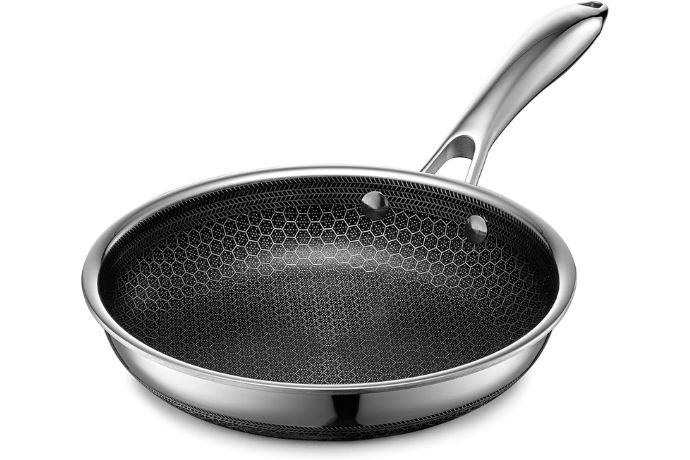
Nonstick 8-Inch Frying Pan
Oven-Safe Up to 900°F, Induction Ready, Compatible with All Cooktops.
Common Misconceptions About Nonstick Cookware
One common myth is that nonstick pans can’t handle any heat — but that’s not entirely true. While extreme heat can degrade the coating, modern nonstick pans can easily handle medium to medium-high temperatures. Another misconception is that nonstick surfaces are unsafe. In reality, when used properly (avoiding overheating or scratching), nonstick cookware is perfectly safe for everyday use.
It’s also worth noting that nonstick pans aren’t disposable. With gentle care — such as using wooden or silicone utensils and washing by hand — they can last several years. The key is understanding their limits and using them for the right recipes.
What Is Stainless Steel Cookware?
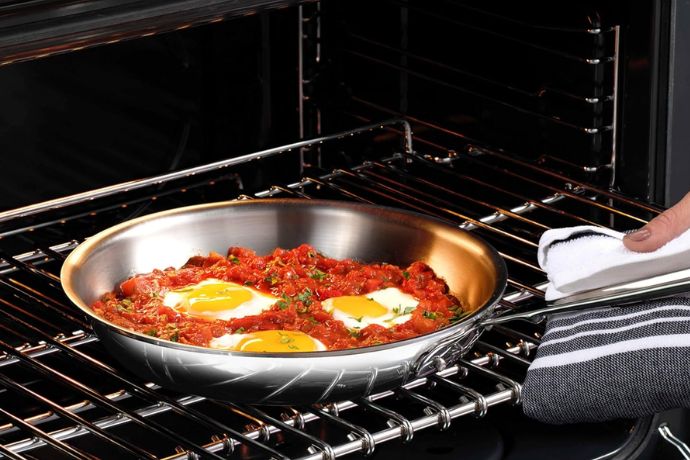
The Science Behind Stainless Steel
Stainless steel cookware is built from an alloy of steel, chromium, and nickel. The chromium forms a protective layer that prevents rust and corrosion, while nickel adds strength and shine. Unlike nonstick, stainless steel has no coating; its natural surface allows you to develop complex flavors through caramelization and browning.
High-quality stainless steel pans often feature multi-ply or tri-ply construction, with layers of aluminum or copper sandwiched between steel layers. This design ensures even heat distribution without hotspots — a critical factor for precision cooking.
Advantages and Limitations
Stainless steel cookware is practically indestructible. You can use it on any stovetop, in the oven, or even under the broiler. It doesn’t react with acidic foods like tomatoes or vinegar, ensuring pure flavors every time. It’s also dishwasher-safe and resistant to scratches.
However, the downside is the learning curve. Food can stick if the pan isn’t preheated correctly, and cleaning burnt residue may require effort. But once you master the technique — preheat, add oil, then food — stainless steel becomes your most reliable kitchen companion.
Why Professional Chefs Love Stainless Steel
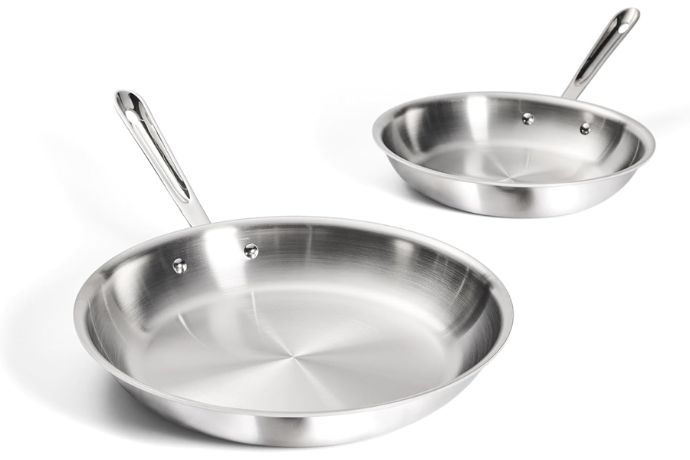
All-Clad D3 3-Ply Stainless Steel Fry Pan Set 2 Piece, 10, 12 Inch
Induction Oven Broiler Safe 600F, Kitchen Cooking Set, Skillets, Durable Frying Pans.
Walk into any professional kitchen, and you’ll see stainless steel everywhere. Chefs love its responsiveness, durability, and the control it offers. You can easily deglaze it to create restaurant-quality sauces, achieve perfect sears, and maintain consistent heat. Plus, its sleek, timeless look complements any kitchen style.
Simply put, stainless steel is the cookware of craftsmanship — made for those who see cooking as an art form.
Nonstick vs. Stainless Steel: Key Differences
Material and Construction
Nonstick pans rely on coatings for performance, while stainless steel relies on the quality of the metal itself. Nonstick cookware is typically lighter, whereas stainless steel is heavier and sturdier. The key difference lies in durability — stainless steel can last a lifetime; nonstick may need replacement after a few years.
Heat Conductivity and Performance
Nonstick heats quickly and evenly at moderate temperatures but struggles with high-heat tasks like searing. Stainless steel, especially with aluminum or copper cores, excels in heat distribution and retention — making it ideal for high-temperature cooking.
Cleaning and Maintenance Comparison
Nonstick wins for easy cleaning — most food residues simply wipe away. Stainless steel requires more effort but rewards you with long-term beauty and resilience. Stuck food can often be removed with baking soda or vinegar, restoring the shine effortlessly.
Cooking Experience: Which Performs Better in the Kitchen?
Nonstick Cookware for Easy Everyday Meals

Nonstick cookware is all about simplicity and speed — two things every busy cook values. Whether you’re scrambling eggs, flipping pancakes, or reheating leftovers, the nonstick surface ensures that food slides right off without sticking or burning. That means less oil, less hassle, and less scrubbing afterward.
The smooth coating makes it a great choice for light, low-fat cooking, especially for those who want to minimize the use of butter or oil. You can whip up delicate dishes like omelets or crepes that would otherwise stick to stainless steel pans. And because nonstick cookware heats up quickly, it’s perfect for quick weekday meals or when you’re short on time.
However, nonstick cookware isn’t the best choice for every dish. It doesn’t develop that beautiful golden crust on meats or allow you to create rich, flavorful sauces from pan drippings. It’s more about convenience than culinary complexity. So if you prefer easy cooking with minimal mess, nonstick wins hands down — but it’s not the tool for high-heat, flavor-intensive recipes.
Stainless Steel for Searing and Flavor Development
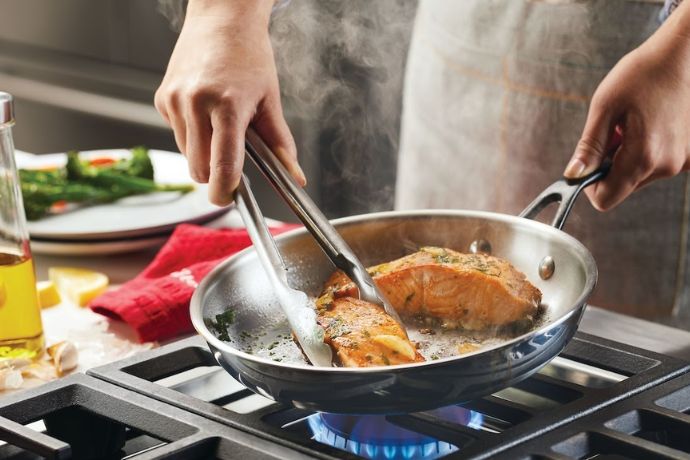
If nonstick cookware is the convenience king, stainless steel is the flavor master. Stainless steel pans excel when it comes to searing meat, caramelizing vegetables, or browning mushrooms — all the techniques that add deep, rich flavor to your dishes. Because it can handle high heat, you can achieve that perfect golden crust that locks in juices and enhances taste.
When you sear meat in a stainless steel pan, tiny bits of food stick to the surface — these are called fond. Deglazing the pan with wine, broth, or sauce lifts those caramelized bits, creating mouthwatering sauces that nonstick pans simply can’t replicate. That’s why most professional chefs prefer stainless steel when cooking savory dishes.
The downside? There’s a bit of a learning curve. You need to preheat the pan and use the right amount of oil. But once you get the hang of it, stainless steel offers unmatched results and transforms your home cooking into restaurant-quality meals.
The Learning Curve: Which Is Easier for Beginners?
For absolute beginners, nonstick cookware is undoubtedly the easier option. You don’t have to worry about food sticking, preheating, or perfect oil timing. It’s forgiving — even if you’re not confident in the kitchen yet.
Stainless steel, on the other hand, requires a bit more technique. You must let it preheat properly, understand temperature control, and use the right amount of fat. But once you master it, you’ll enjoy greater versatility and control over your cooking.
In essence, nonstick cookware is beginner-friendly, while stainless steel rewards skill and experience. A combination of both in your kitchen lets you grow as a cook while enjoying the best of both worlds.
Health and Safety Concerns
Are Nonstick Coatings Safe?
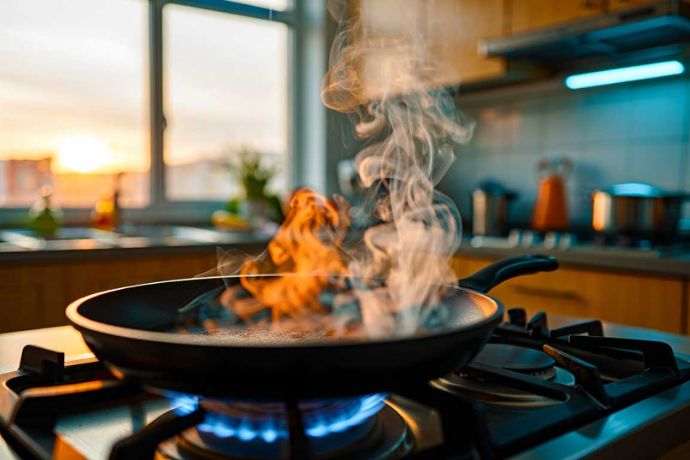
The biggest concern people have about nonstick cookware is the coating. Older nonstick pans used to contain PFOA — a chemical linked to health issues. However, modern nonstick cookware is 100% PFOA-free, making it safe for regular cooking when used correctly.
The real risk arises from overheating nonstick pans above 500°F (260°C), which can release fumes harmful to birds and potentially irritating to humans. But under normal cooking conditions, this rarely happens. The key is simple: don’t preheat an empty nonstick pan, and avoid cooking on high heat for long periods.
Also, avoid using metal utensils that can scratch the coating. Once the surface starts peeling, it’s time to replace the pan. With mindful use, nonstick cookware remains one of the safest and easiest options for everyday cooking.
Stainless Steel and Metal Leaching: Is It a Risk?
Stainless steel cookware is considered extremely safe. It doesn’t have a chemical coating and is resistant to rust, corrosion, and leaching. However, small amounts of metals like nickel or chromium can leach into food, especially when cooking acidic dishes (like tomato sauce) for long periods.
For most people, this isn’t a health risk. In fact, high-quality stainless steel (such as 18/10 grade) minimizes leaching almost completely. People with nickel allergies should choose nickel-free stainless steel to stay safe.
Overall, stainless steel is one of the most non-reactive and durable cooking materials you can own, making it a top choice for health-conscious cooks.
Tips for Safe Cooking Regardless of Material
Whether you use nonstick or stainless steel cookware, a few safety habits go a long way:
- Avoid overheating any pan — it degrades coatings and warps steel.
- Use wooden, silicone, or plastic utensils on nonstick cookware.
- Clean gently — never use harsh abrasives or steel wool.
- Store properly by stacking with protective layers between pans.
- Inspect regularly for damage or discoloration, and replace when necessary.
Good cookware care is as important as the cookware itself. Handle it right, and both types will serve you well for years.
Durability and Longevity
How Long Does Nonstick Cookware Last?
Nonstick cookware isn’t built to last forever — and that’s okay. Its main appeal lies in convenience, not longevity. Most high-quality nonstick pans last between 3 to 5 years with proper care. However, frequent use, metal utensils, and high heat can shorten their lifespan.
To extend the life of your nonstick pans:
- Always use medium heat or lower.
- Wash them by hand, even if labeled dishwasher-safe.
- Avoid aerosol cooking sprays, as they leave residue that’s hard to remove.
When you notice scratches, peeling, or uneven surfaces, it’s time for a replacement. Investing in a good nonstick pan every few years is still cost-effective for the comfort and ease it brings to everyday cooking.
Stainless Steel’s Lifetime Appeal
If nonstick is short-term convenience, stainless steel is long-term reliability. A quality stainless steel pan can literally last decades — even a lifetime. That’s why many brands back them with lifetime warranties. They resist warping, scratching, and rusting, and they can handle any cooking method, from stovetop to oven to dishwasher.
Even if your stainless steel cookware develops discoloration or burnt residue, it’s easy to restore. A bit of vinegar, baking soda, or specialized cleaner brings back the shine. With minimal effort, it looks new again.
For home cooks who see cookware as an investment, stainless steel is the clear winner. It may require a bit more maintenance, but it’s built to stand the test of time.
Investing in Quality Cookware for the Long Run
In the long run, stainless steel offers better value for money. While nonstick cookware is cheaper upfront, it needs replacement every few years. Stainless steel costs more initially but can serve you for life.
If you’re building your kitchen from scratch, a balanced approach works best — invest in a good stainless steel set for everyday cooking, and keep one or two nonstick pans for eggs, pancakes, and delicate dishes. This combination covers all your cooking needs efficiently.
Cost Comparison: What’s the Better Value?
Initial Cost vs. Long-Term Investment
Nonstick cookware tends to be more affordable upfront. A quality nonstick frying pan can range from $25 to $80, while premium stainless steel sets can easily exceed $300. But when you factor in longevity, stainless steel often comes out on top.
Think of it this way — replacing a $40 nonstick pan every four years adds up over time, while one $150 stainless steel pan could last decades. If you cook often, the long-term investment in stainless steel is worth every penny.
Balancing Quality with Budget
If you’re on a budget, there’s no need to splurge on an entire cookware set. Start small. Buy one good stainless steel skillet and one nonstick pan. This combo lets you handle most recipes easily while keeping costs low.
When shopping, look for trusted brands with proven quality. Avoid cheap, thin nonstick pans that warp easily or stainless steel sets that lack core layers — they may seem affordable, but they’ll cost more in replacements down the road.
When to Splurge and When to Save
Spend more on stainless steel pieces that you’ll use daily — like sauté pans, stockpots, and saucepans. For nonstick, save by buying just the essentials — an 8-inch or 10-inch skillet is usually enough.
Ultimately, smart kitchen investing isn’t about buying the most expensive cookware — it’s about buying the right cookware that matches your needs, habits, and long-term goals.
Maintenance and Cleaning Tips
Caring for Nonstick Cookware
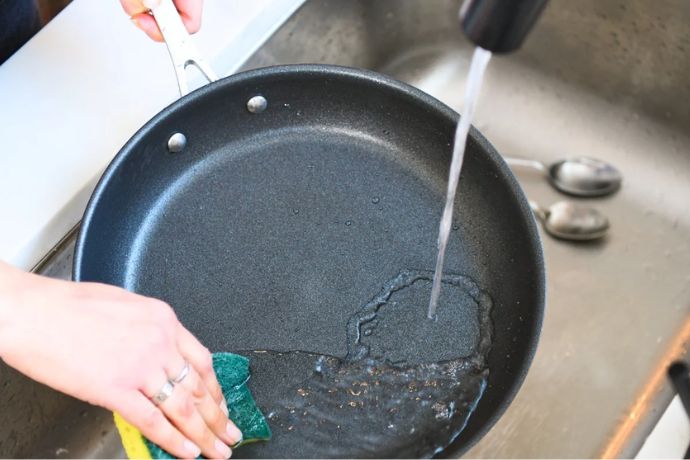
Taking care of nonstick cookware properly is the key to maintaining its slick surface and extending its lifespan. Unlike stainless steel, nonstick pans need gentle handling to keep their coating intact. Here’s the golden rule: no metal utensils, no high heat, and no harsh scrubbing.
Start by allowing the pan to cool down after cooking. Washing it while hot can cause thermal shock and weaken the coating over time. Always use warm, soapy water and a soft sponge or cloth. Avoid abrasive pads or steel wool — they can scratch the surface and reduce its nonstick quality.
When cooking, keep the temperature moderate. Nonstick coatings are designed for low to medium heat. High temperatures can break down the coating, releasing unpleasant fumes and shortening the pan’s life.
If you’re using cooking sprays, switch to oil or butter instead. Sprays tend to build up a sticky residue that’s difficult to remove. And when storing, don’t stack other pans directly on top without a protective liner (like a paper towel or soft cloth) — this prevents scratches.
With proper care, even a mid-range nonstick pan can last years while keeping that effortless glide that makes cooking enjoyable.
Cleaning and Restoring Shine to Stainless Steel
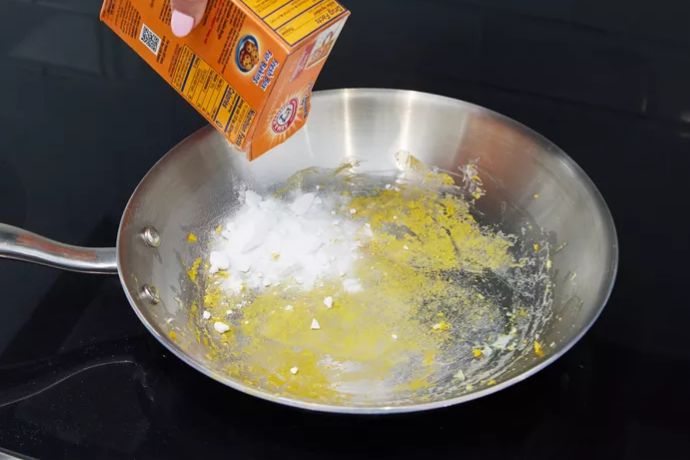
Cleaning stainless steel cookware can feel intimidating, but it’s easier than it looks — especially when you understand how to treat it. For everyday cleaning, warm water, mild dish soap, and a sponge usually do the trick. For stubborn spots or burnt-on food, fill the pan with water, bring it to a boil, and scrape gently with a wooden spatula. This method helps loosen residue without damaging the surface.
To restore its shine, you can use a paste made from baking soda and water. Gently rub it onto the surface, rinse, and dry with a microfiber cloth. For discoloration (like rainbow stains caused by overheating), a splash of white vinegar works wonders — it reacts with the mineral buildup and restores the natural luster.
One key tip: always dry stainless steel immediately after washing. Leaving it wet can cause water spots and dullness.
Unlike nonstick cookware, stainless steel can handle scouring pads and stronger cleaners if needed. Just avoid using bleach or harsh chemical agents, which can corrode the surface. With a little patience and care, your stainless steel pans will stay shiny, spotless, and professional-looking for years.
Common Mistakes to Avoid
Many home cooks unintentionally shorten the life of their cookware by making a few common mistakes. Here’s what to watch out for:
- Using metal utensils on nonstick cookware – This is the quickest way to ruin the coating. Stick to wood, silicone, or nylon.
- Preheating nonstick pans while empty – This can cause overheating and damage the coating within minutes.
- Skipping the preheat for stainless steel – Food sticks easily if you don’t let it heat up properly before adding oil.
- Using cold water on a hot pan – Rapid temperature changes can warp both types of cookware.
- Neglecting to dry stainless steel – Leaving it wet causes those annoying water stains.
Avoid these pitfalls, and your cookware will perform beautifully and last much longer.
Environmental Impact of Nonstick vs. Stainless Steel
Eco-Friendliness of Production and Disposal
When it comes to environmental impact, stainless steel cookware has a clear edge. It’s made from natural metals that can be recycled indefinitely without losing quality. Most stainless steel cookware is even made with a portion of recycled material, making it a sustainable choice from production to disposal.
Nonstick cookware, on the other hand, presents some environmental challenges. The coatings, particularly PTFE-based ones, are not biodegradable, and manufacturing them involves chemical processes that require careful regulation. That said, many modern brands are shifting toward eco-friendly ceramic coatings that are free from PFAS, PTFE, and PFOA — a big step forward for sustainability.
The biggest factor remains longevity. Stainless steel’s long lifespan means less waste over time. Nonstick pans, which often need replacement every few years, contribute more frequently to landfills unless properly recycled.
Longevity and Waste Reduction
Sustainability in cookware isn’t just about the material — it’s about how long it lasts. A stainless steel pan can serve you for decades, which drastically reduces waste. Even if it gets old or scratched, it can be polished or recycled into new products.
Nonstick pans, while convenient, tend to have a shorter life. However, responsible use and disposal can help minimize their environmental footprint. Some brands now offer recycling programs for used cookware, allowing you to return old pans for proper material recovery.
Choosing cookware that lasts longer and is made responsibly helps reduce overall waste — and that’s something every cook can feel good about.
Choosing Sustainable Brands
If you’re eco-conscious, research brands that prioritize sustainability in both nonstick and stainless steel cookware. Look for:
- Recyclable materials and eco-friendly packaging.
- Ceramic-based coatings free from PFAS and PFOA.
- Ethical manufacturing practices with reduced carbon emissions.
Brands like GreenPan, All-Clad, and Made In have been leading the charge in creating long-lasting, eco-responsible cookware.
When you choose quality and sustainability together, you’re not just investing in your kitchen — you’re contributing to a greener planet.
Related Articles
Cooking Results: Taste and Texture
Does Cookware Affect Food Flavor?
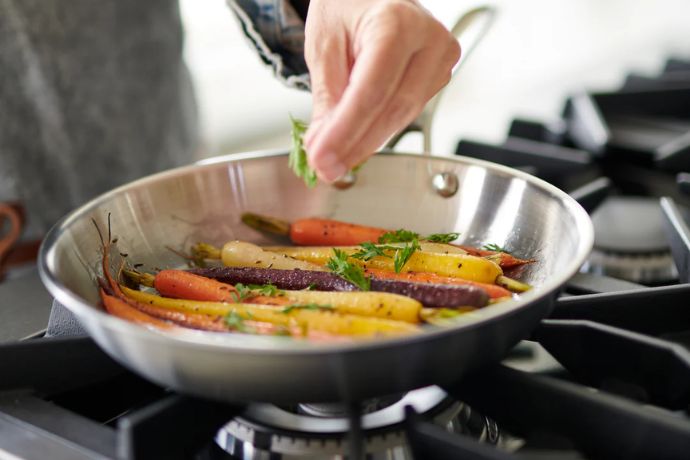
Absolutely — your cookware plays a big role in how your food tastes. While nonstick pans are great for delicate recipes, they don’t allow for the same browning and flavor development as stainless steel. The reason lies in the Maillard reaction — the process that gives seared meat, roasted vegetables, and toasted bread their deep, rich flavor.
Nonstick pans, due to their coating, limit this reaction since the surface doesn’t get as hot. That’s why dishes cooked in nonstick cookware tend to have a softer texture and milder flavor. On the other hand, stainless steel allows high temperatures and direct contact with the metal, enhancing taste through caramelization and browning.
In other words, if flavor depth is your priority, stainless steel cookware wins every time.
Browning, Crisping, and Texture Comparison
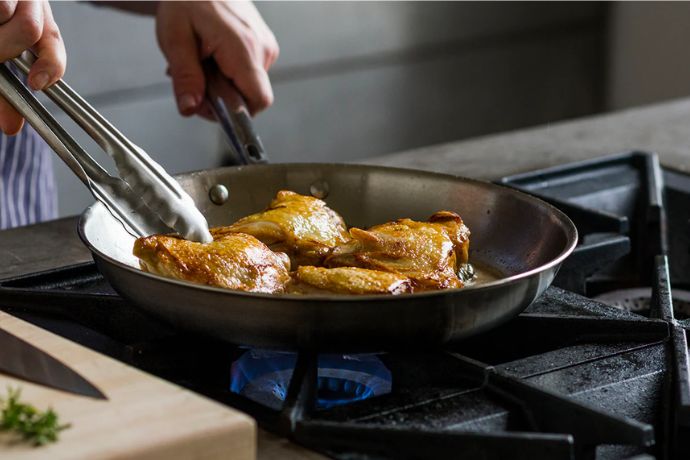
When it comes to texture, stainless steel cookware takes the lead again. It allows you to achieve crispier edges on meats, vegetables, and even tofu. You get that restaurant-quality crust that locks in moisture and flavor. Nonstick pans, while smoother and gentler, don’t offer that same crisp finish — they’re better for foods that need a soft texture, like scrambled eggs or crepes.
The trade-off is clear:
- Nonstick cookware = smooth texture, less oil, perfect for delicate foods.
- Stainless steel cookware = crisp, flavorful texture, ideal for searing and sautéing.
Both have their place in the kitchen, depending on the type of dish you’re aiming to perfect.
Real-Life Cooking Examples
Let’s put it into practice.
- Nonstick cookware shines when making fluffy omelets, golden pancakes, or tender fish fillets. You won’t need much oil, and cleanup is a breeze.
- Stainless steel cookware is unbeatable for steak, stir-fried vegetables, and sauces that need deglazing. You’ll capture those deep, savory flavors nonstick simply can’t match.
In short, use nonstick for gentle, low-oil cooking and stainless steel when you want to impress with bold, flavorful meals.
The Best Uses for Each Type
When to Use Nonstick Cookware
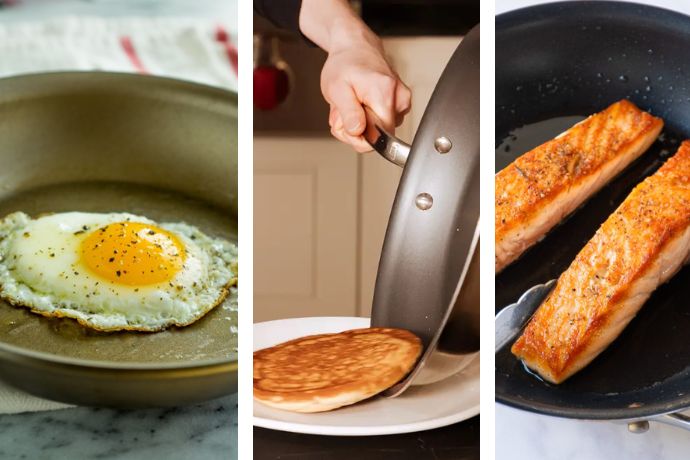
Use nonstick cookware when:
- Cooking delicate foods like eggs, crepes, or fish.
- Preparing low-fat meals with little or no oil.
- You need quick, mess-free cleanup.
- You’re reheating or simmering light sauces.
It’s best for quick, everyday cooking where convenience is your main goal.
When Stainless Steel Shines
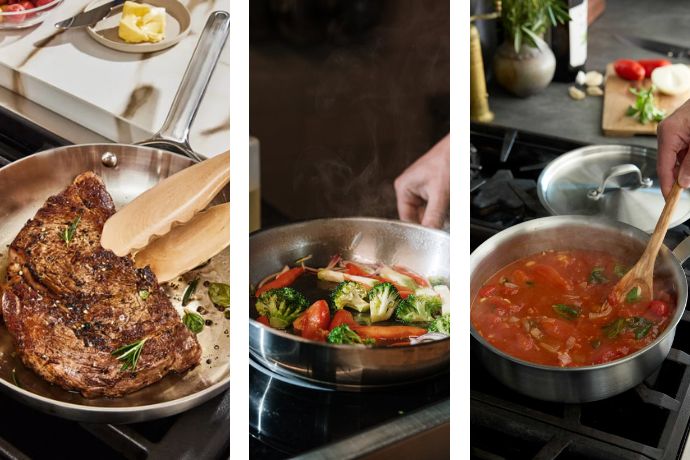
Reach for stainless steel cookware when:
- You’re searing meats or sautéing vegetables.
- Making soups, sauces, or pasta dishes.
- Cooking at high heat or using the oven.
- You want to develop rich flavors and textures.
It’s the go-to for ambitious cooking — perfect for those who love experimenting and mastering their skills.
Combining Both for a Perfect Kitchen Setup
The ultimate kitchen doesn’t choose between the two — it embraces both. A hybrid cookware collection ensures you’re prepared for any recipe.
Here’s a smart setup:
- 1–2 nonstick pans (for eggs, pancakes, and fish).
- A stainless steel sauté pan and saucepan (for sauces, stir-fries, and searing).
- A stainless steel stockpot (for soups and boiling pasta).
By combining both, you balance convenience with performance — creating the perfect kitchen arsenal for every kind of cook.
Expert Opinions and Chef Recommendations
What Professional Chefs Say
Ask any professional chef about the cookware they use, and most will swear by stainless steel. The reason is simple — it provides complete control over temperature and allows for techniques like deglazing, searing, and reducing sauces that simply can’t be done as effectively on nonstick surfaces. In professional kitchens, stainless steel is considered the “workhorse” of cookware because it can endure constant use, high heat, and even metal utensils without losing performance.
However, that doesn’t mean chefs completely dismiss nonstick cookware. In fact, many culinary professionals keep a few nonstick pans on hand for specific tasks. Nonstick pans are perfect for delicate items like omelets, crepes, and fish fillets — anything that might tear or break apart on a stainless steel surface.
Celebrity chefs like Gordon Ramsay and Thomas Keller often recommend a hybrid kitchen setup. Ramsay himself has mentioned that while stainless steel is ideal for achieving flavor depth, nonstick pans are invaluable for everyday, hassle-free cooking. The best cooks don’t pick sides — they simply use the right tool for the job.
Popular Brands Among Experts
When it comes to trusted cookware brands, professionals tend to favor quality over cost. For stainless steel, All-Clad, Made In, and Demeyere are top choices. These brands offer multi-ply construction with aluminum or copper cores, providing even heat distribution and exceptional durability.
For nonstick cookware, brands like GreenPan, Calphalon, and T-fal are chef-approved for their advanced coatings and safety standards. GreenPan, for instance, has revolutionized the industry with ceramic-based nonstick coatings that are PFAS-free and eco-friendly.
In essence, the best cookware brand is the one that balances performance, longevity, and safety — whether it’s a high-end stainless steel set or a reliable nonstick pan for everyday use.
Lessons from Culinary Schools
Culinary schools teach students to master stainless steel first. That’s because learning to cook with stainless steel helps you understand temperature control, oil behavior, and the chemistry of food contact. If you can cook an egg in stainless steel without sticking, you’ve truly honed your technique.
Once you’ve mastered stainless steel, switching to nonstick cookware becomes effortless. Nonstick pans act as an aid for efficiency, not a crutch. That’s why even in professional kitchens, chefs often use nonstick pans strategically — not exclusively.
The takeaway from the pros? Use nonstick for convenience, stainless steel for craftsmanship, and know how to make the most of both.
Final Verdict: Nonstick vs. Stainless Steel Cookware
Which Is Better for Everyday Cooking?
So, when it comes down to it — nonstick vs. stainless steel cookware, which is truly better for everyday cooking? The answer depends on your cooking habits, skill level, and lifestyle.
If you value ease, speed, and low-maintenance cooking, nonstick cookware is your best ally. It’s ideal for busy mornings, quick dinners, or anyone who wants to cook healthier meals with minimal oil.
But if you prioritize flavor, versatility, and longevity, stainless steel wins without question. It lets you explore advanced cooking methods, withstands high heat, and can last a lifetime with proper care.
In short:
- Choose nonstick cookware for convenience and simplicity.
- Choose stainless steel cookware for power and precision.
- Or, even better, use both and enjoy the best of both worlds.
Tailoring Your Choice to Your Lifestyle
The best cookware is the one that fits your life. If you’re a busy professional who just wants to cook fast, nonstick is perfect. If you love experimenting with flavors, entertaining guests, or cooking gourmet-style meals, stainless steel is worth the investment.
Think about your priorities — time, taste, maintenance, and budget. Then, build your kitchen around them. There’s no one-size-fits-all answer, only what works for you.
The Smart Kitchen Balance
A truly smart kitchen isn’t filled with one type of cookware — it’s balanced. Have one or two quality nonstick pans for quick, delicate dishes and a durable stainless steel set for everything else. This combination not only makes you a more versatile cook but also ensures you’re ready for any recipe that comes your way.
In the end, nonstick and stainless steel cookware aren’t rivals — they’re partners. Together, they create a kitchen setup that’s efficient, flavorful, and built to last.
Conclusion
Wrapping Up the Cookware Debate
When comparing nonstick vs. stainless steel cookware, it’s clear that both bring unique strengths to the table. Nonstick offers effortless cooking and easy cleaning, perfect for quick meals and beginners. Stainless steel, on the other hand, delivers professional-level results, superior durability, and the ability to create complex, flavorful dishes.
Your final choice depends on how you cook. If you want simplicity and speed, go with nonstick. If you love precision, durability, and rich taste, stainless steel is your go-to. For most home cooks, a mix of both is the ultimate solution — nonstick for ease and stainless steel for excellence.
Cooking isn’t just about recipes; it’s about experience, passion, and tools that make it enjoyable. With the right balance of cookware, every meal becomes an opportunity to create something delicious, healthy, and memorable.
FAQs
1. Which cookware lasts longer: nonstick or stainless steel?
Stainless steel cookware can last a lifetime when properly maintained, while nonstick pans usually last around 3–5 years before the coating starts to wear off.
2. Can I use metal utensils on nonstick pans?
It’s best to avoid them. Metal utensils can scratch or damage the coating. Use wooden, silicone, or nylon utensils instead to preserve the surface.
3. Is stainless steel better for health?
Yes. Stainless steel doesn’t have coatings or chemicals, making it one of the safest and most non-reactive cookware options available.
4. How can I make food not stick to stainless steel pans?
Preheat the pan first, then add oil before adding food. This creates a temporary nonstick layer and prevents sticking.
5. What’s the best cookware set for beginners?
A starter setup should include one good nonstick skillet for quick cooking and one stainless steel sauté pan for searing and sauces. This combo covers most everyday needs.

